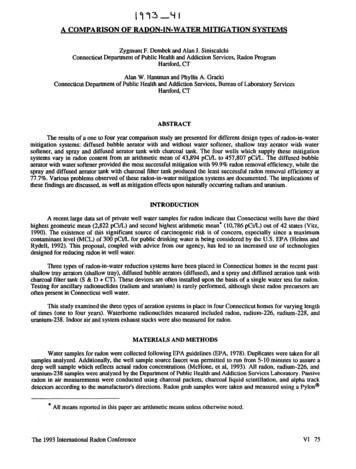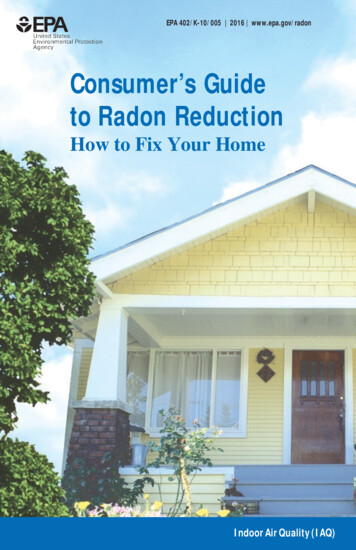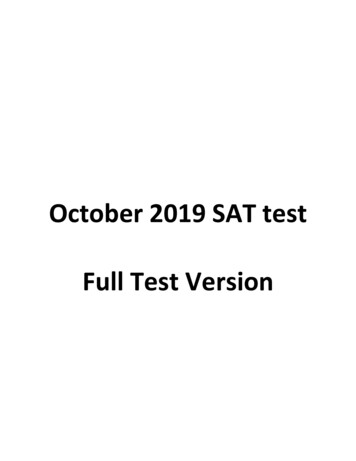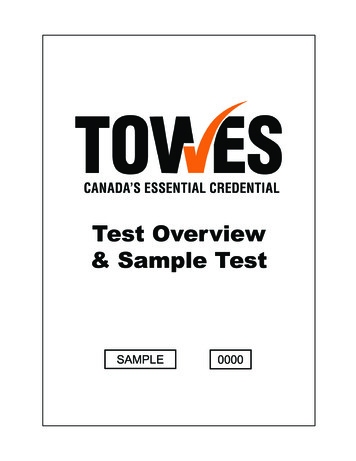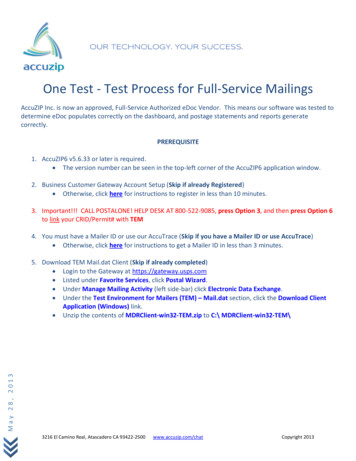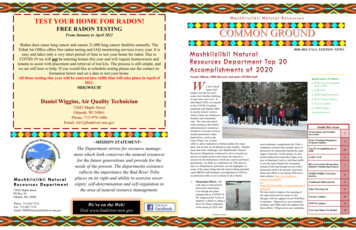
Transcription
161M a s h k i i z i i b i i N a t u r a l Re s o u r c e sTEST YOUR HOME FOR RADON!FREE RADON TESTINGFrom January to April 2021Radon does cause lung cancer and causes 21,000 lung cancer fatalities annually. TheTribal Air Office offers free radon testing and IAQ monitoring services every year. It iseasy and takes only a very short period of time to test your home for radon. Due toCOVID-19 we will not be entering homes this year and will require homeowners andtenants to assist with placement and retrieval of test kits. The process is still simple, andwe are still here to help. If you would like to schedule testing please use the contact information below and set a date to test your home.All those testing this year will be entered into raffle that will take place in April of2021.MIIGWECH!Daniel Wiggins, Air Quality Technician72682 Maple StreetOdanah, WI 54861Phone: 715-979-1486Email: Air1@badriver-nsn.gov MISSION STATEMENT Mashkiiziibii NaturalResources Dep ar t ment72682 Maple StreetPO Box 39Odanah, WI, 54806Phone: 715-682-7123Fax: 715-682-7118Email: NRDOutreach@badriver-nsn.govThe Department strives for resource management which both conserves the natural resourcesfor the future generations and provide for theneeds of the present. The departments existencereflects the importance the Bad River Tribeplaces on its right and ability to exercise sovereignty, self-determination and self-regulation inthe area of natural resource management.We’re on the Web!Visit www.badriver-nsn.govNaomi Tillison, NRD Director and entire MNRD StaffSpecial points of interest:We have facedmany challenges over the last year –some were familiar challenges and some were new. Inmid-March 2020, we reactedto the COVID-19 globalpandemic and flipped NRDto mostly remote work inorder to keep our employees,families and communitysafe. We were also facedwith reacting to the federaladministration’s numerousinitiatives to loosen environmental protections underfederal laws, such as theClean Water Act, in theireffort to allow industries to further pollute the water,land, and air that we all depend on stay healthy. Despitethese and other challenges, the Mashkiiziibii NaturalResources Department continued to strive towards ourmission to better protect and restore the natural resources for the betterment of both the current and futuregenerations. In 2020, we celebrated our 35th anniversary as a Department, and below are the highlights ofsome of the many things that the hard working and dedicated MRND staff members accomplished in 2020 (inno particular order as we’re proud of all of them):1.Manoomin Efforts. Wetook steps to help protectand restore manoomin,even though our planschanged due to COVID-19.We supported the Town ofSanborn’s efforts to adopt aSlow No Wake Ordinancein the spring of 2020; this Continued on page 4 MNRD Top 20 Accomplishments of 2020 EARLY ICE MNRD Staff Introductions Water Program Updates Forestry Updates POWTS UpdatesAnd so much more!Inside this issue:town ordinance compliments the Tribe’sordinances and provides another layer ofprotection for manoomin during the earlystages of growth. In the spring, we alsoposted manoomin restoration signs at anarea in Beartrap Creek to curb boat trafficto use the main channel for navigatinginstead of driving through an area wheremanoomin used to be present; read moreabout this effort in our spring 2020 newsletter edition: /07/202007 CommonGround Spring.pdfWe also tried to improve the opening ofthe manoomin harvest season in theSloughs with the support of our Wild RiceCommittee. Miigwech to our committeemembers and NRD staff who helped withthese efforts ! Miigwech to our committeeWood Smoke and WeatherInversions2Water-Wetlands RegulatoryProgram Updates3Top 20 Accomplishments of20204-5EARLY ICE6BIA Great Lakes RestorationInitiative Monitoring Projects7MNRD Wildlife Tech Introduction8Traditional Ojibwemowin9Solar Powering Up!11Forestry Updates13POWTS Updates14Test Your Home For Radon!16
Page 2215COMMON GROUNDPage 15Wood Smoke and Weather InversionsNathan Kilger, Mashkiiziibii Air Quality Specialistairquality@badriver-nsn.gov19. Partnerships. MNRD continued to collaborate with partners (mostlyvirtually) on a variety of issues and projects to protect and restore the BadRiver watershed and the Lake Superior basin. The Lake Superior Partnership (a bi-national partnership), the Lake Superior Collaborative (a regional partnership), and the Wisconsin Tribal Conservation AdvisoryCouncil (WTCAC) are just a few of the partnerships that MNRD staffparticipated in (mostly virtually).With cold weather slowly moving in this time ofyear, weather conditions can combine withsmoke from wood stoves and industrial sources across theregion to create fine particulate pollution at times throughout the winter season. The Red Cliff Air Program Managernoticed the first such episode around November 26th andwe started seeing a similar pattern on December 8th.20. Building Department Capacity. MNRD has worked hard to maintainand build Department capacity over the last year or so, including the creation of eight (8) new full-time positions: Water Regulatory Specialist,Manoomin Oshkaabewis, Deputy Director, Deputy THPO, Land RecordsIn-Take Specialist, Wildlife Technician, Ornithology Specialist, and bakaan ingoji gaa-Ondaadag (Non-Local Beings) Program Manager. Pleasestay tuned for additional positions as we continue to build the capacitythat we need to match our workload requirements.This gives me a great reason to explain some of the weatherthat contributes to these fine particulate pollution episodes the weather phenomenon is called an “inversion”. This isone of those points where weather and air quality intersect.Like most air pollution, inversions are usually invisible, butthere are tools we can use to identify when they are happening. Forecasting inversions are a bit harder, especially morethan a day into the future.The lowest layer of the atmosphere is called the troposphere, this is the layer where weather occurs, and this layercan be up to 50,000 feet high. As you rise up in this layer ofair the air gets colder and colder. The temperature outsideairplanes as you fly across the country is often -100 F atflight height (I like watching the flight screen informationwhen I fly). Therefore, as everyone remembers from theirhigh school physics class, because a warm bubble of air isless dense than the cooler air above it, air near the groundusually wants to rise up through the atmosphere . This rising helps keep the atmosphere mixed up, and acts todilute air pollution. Butthere are times when thatbubble cannot rise up.We hope you’ve enjoyed our top 20 highlights of 2020,and we’re excited to share more with you about the goodwork the Mashkiiziibii NRD has been doing. We’relooking forward to thecollaborations andpartnerships in 2021and seeing what wecan learn and accomplish together. Wehope you take care ofAki (Land), Nibi(Water), and eachother!Miigwech to Mashkiiziibii NRD staff for all your hard work and dedication!Miigwech for the support of the Tribal Council and other Departments (HumanResources, Accounting, Legal, and more) who helped support these efforts!Miigwech to our partners and funders who helped support these efforrts!An example skew-t plot that shows a strong inversion 2,500 feetabove the ground.ple days, but sensitive population groups such as asthmaticsor people with other lung issues or diseases can start to feelthis level of air pollution. COVID-19 is one of these diseases that can be made worse by poor air quality.These inversion pollutionevents happen throughoutthe winter, sometimes for aday, but during unusualperiods can last up to aweek. The best way to tellif smoke pollution is starting to cause air pollutionproblems is to check theWisconsinAQM app onyour phone or this statewideweb link: https://airquality.wi.gov/home/mapIf a warmer layer of air is atsome level of the atmosphere, the bubble rises upand then stops when it hitsthis different layer. Thewarm layer can be close tothe ground, higher up, orthere can be several of theseat different heights. WhenI wanted to say thank you tothe warm layer is close tothe Red Cliff Air Programthe ground, any woodManager for the inspirationsmoke and other air polluImage credit: Union Public Service Commissionfor this article and for thetion can’t rise up and staysconversations we have concerning local air quality that imtrapped down at our level and we then breathe that pollupacts our respective Reservations and residents. If you’re ation.science geek reading this article, do an internet search forterms “skew-t plots” and “weather inversions”. If reading aNovember 26th and December 8th were two inversions soskew-t plot is something you’re comfortable with and youfar this winter. The air monitoring equipment in Odanahwant to try forecasting inversions, a search for “BUFKIT”measured air quality at the “Moderate” level, usually notwill start you on your way down that rabbit hole.enough to impact human health over several hours or a cou-Biindige (Come In) Megan Powless to theTHPO Wigamigong (Building)! Megan started hernew position as the THPO Assistant on October5th (We stole her from the Health DepartmentCamp ) We are glad to have her with theTHPO Team in the Mashkii Ziibii Natural Resources Department!Weweni Boozhoo (Welcome) Megan!
Page 14143COMMON GROUNDPage 3POWTS UpdatesIts been a tough year! All the delays/postponements due to theCovid-19 pandemic. Although starting very late in the con-struction season we managed to complete all of the “old work”carried over from last year and even some new projects. Our tribalPOWTS Program is assisting #20 Bad River tribal members to planfor future water and sewer work here at Bad River. They are invarious stages of the POWTS process some just filing their applications, others applying for leases and still others ready for work nextyear. We also assist tribal members who are building off the reservation in other counties or states. POWTS is also assisting the BadRiver Tribe in other tribal projects such as the Bad River WakeHouse, the “tiny homes” project, Fire Hall, Tribal storage buildings, and the tribal treatment and healing center. POWTS (PrivateOn-site Wastewater Treatment Systems) is open to all qualifiedBad River tribal members. Our program provides safe, modern,water, and sewer services to tribal members who are building a newhome or setting up a trailer. IHS provides our tribe with funding toown or have tribal leases before they are considered for funding.Tribal members are allowed to access this type of IHS funding onlyonce. They will not do emergency repair or replacement work butwill repair or replace any POWTS work completed within a oneyear period from the final inspection date, of work we have donethrough Bad River POWTS. After this one year grace period it fallson the homeowner to cover the cost of any repair/replacement workShea Schachameyer, Wetlands Specialistwetlands@badriver-nsn.govThe Water-Wetlands Regulatory Program had a big year and here's asummary of our accomplishments:49 NRD Project Reviews; 15 Wetland Deline-needed. In the last four years the Ashland IHS Office was closedations & Concurrences; 28 Wetland & Water-but has recently been re-opened and is fully staffed once again.course Protection Ordinance determinations;Their engineers and specialist provide technical/engineering adviceand assistance to our tribe. I encourage and advise that any tribal13 Antidegradation Demonstration decisions;member who is considering building to begin the POWTS applica-and 6 Clean Water Act Section 401 Certifica-tion process as early as possible as it can be a lengthy process. Thetion decisions. In June we were also able toPOWTS Office is located in the Chief Blackbird Center, MNRD.hire Lorrie Salawater as our Water RegulatoryOur office phone number is 715-682-7123 ext. 1663, cell number is715-685-8727, and e-mail is: powts@badriver-nsn.gov OfficeSpecialist, a new position for our program!Wetlands Specialist, Shea Schachameyer, conducting fieldwork for one of the fifteen wetland delineations shehours are M-F, 8:00am.- 4:30pm.cover the cost of such services and has contracted with locallyHave a safe, Happy Holiday Season!!owned contractors to do the work. IHS requires that all applicantsGene Bigboy Jr.Melis Arik, Water Resource Specialist wqs@badriver-nsn.govThe Tribe's Indigineous Arts and Sciences (IAS) Program is a collaborationbetween the Education Department,Mashkiiziibii Natural Resources Department, University of Wisconsin - EarthPartnership, other Tribes, and other partners. The focus of the IAS Program is toengage youth and educators in science,math, and arts in a manner that infusesculture and traditional knowledge andmakes it more relevant to tribal youth.On November 30, 2020, the EducationDepartment and Mashkiiziibii NaturalResources Department held a virtualcommunity forum to gather ideas fromthe Bad River community to help deciding the focus of a research project meant tobenefit the Bad River Youth. The researchproject will be implemented in 2021. A synthesis of the project ideas generated duringthe November 30th community forum is asfollows: an illustrated botanical survey(with field collection and with incorporationof two languages) for medicinal purposes.If you have questions, suggestions, or wouldlike to be involved in this research project,please contact Stephanie Julian, EducationDirector, at EducationDirector@badrivernsn.gov. We are hoping to finalize our research project concept in January and appreciate the input received in helping us developand implement this research project.The Water Resources Pro-gram didn't let COVID get in thedays and 177 individualway of monitoring rivers,visits to collect waterstreams, wetlands or beaches.samples. Weekly beachFollowing guidelines to mask upmonitoring continuedand stay distanced, our team con-with few interruptions toducted water quali-make sure thatwater was safe for swimming.ty monitoring at 36the communitySwimming advisories wereriver and streamcould enjoy quali-posted once in May for Joesites and four sitesty beach timeRose and Waverly beaches,in the Sloughs, forwithout worryingand again in July for Joe Rosea total of 43 fieldabout whether theBeach.
Page 4members, Russ Corbine Jr. (former Deputy Director),Brad Bigboy (Chief Warden), and other NRD staff whohelped with these efforts.2.3.4.Virtual Teamwork. Despite all the challenges we havefaced in this unprecedented time of a pandemic, we continue to persevere as a Team. We have mastered the artof using multiple virtual formats to come together andmeet as though we are sitting around the table in conference room – C. Parents on the team can discuss challenges of certain projects affecting the Tribe while calmingtheir children and ensuring they are also connected totheir virtual classrooms. We can walk through the woodsand listen to a webinar or meeting, or discuss an issue, atthe same time. This change that was once thought of as achallenging obstacle to communication, has quickly become the norm for work that may not be lost once we cancome together.Ishkonige Nawadide Solar Microgrid Project. TheAir Office is responsible for the oversight of the construction of the Ishkonige Nawadide Solar Project andhas successfully executed the project thus far and construction has commenced. Construction activities havebeen delayed due to COVID but we continue to pushforward to reach the project’s goals on time. The BadRiver Tribe was awarded a US Department of Energygrant in 2019 for the Ishkonige Nawadide (It CatchesFire) Solar Microgrid Project. The project focused onresiliency after the 2016 Flood and to prevent futureelectrical disruptions at three critical facilities, the Health& Wellness Center, the Waste Water Treatment Plant,and the Administration Building. Through this projectthe Tribe is installing over 500 kW of solar with over1000 kWh of battery storage at each of the three tribalfacilities. The systems at the Health & Wellness Centerand the Waste Water Treatment Plant will offset the5.6.entire facility electrical loads and offer a level of resiliency that will allow the facilities to remain in operation forseveral weeks even if the main power lines fail.-Learn more about this project on page 11.413COMMON GROUNDPage 13Ma’iingan Symposium. TheWildlife Programkicked off 2020by hosting theMashkiiziibiiMa’iingan Symposium in orderto bring togethertribal, state, andfederal governments as well ascommunity members such asfarmers in orderto discuss ourrelationships withMa’iingan and to prepare for the federal delisting of thegray wolf. With around 130 participants in this event,Tribes reflected on the Ma’iingan delisting and hunts in theearly 2010s, federal and state biologists received new understandings of Anishinaabe knowledge and culture, andfarmers came away with new ideas to raise their livestockwhile coexisting with carnivores .-Learn more about ma’iinganfrom our winter 2019-2020 andsummer 2020 newsletter oads/2020/10/2020Summer-Edition.pdfPlanting Over 50,000 Trees.The Forestry Program partneredwith The Nature Conservancy ona large tree planting effortthroughout the Reservation, planting over 50,000 trees. Acontracted crew planted 40,000 white pine and 2,500 silvermaple were in one day at a location off of Pine Flats Road.-Learn more about this project in the Forestry article onpage 13.Cultural Education Facility. We were finally heard toutilize the old burned clinic and combine THPO and Education to create a Cultural Education facility. The THPOpitched the idea to Tribal Council a year after the Clinicinitially burned and remained unused. Other MNRD programs will also be in the facility which emphasizes thateverything in Creation that we currently call natural resources, continue to be an integral part of our culture. Weare picking paint colors this week to be ready for the bigmove in March 2021. The Community can look forward toa prayer pole raising ceremony outside the building andlifting of the eagle feather inside, as a component of theCultural Education Center Opening.continued on page 5.By Gena Abramson, Bad River Forester Forester@badriver-nsn.govAs we progress closer to 2021, BadRiver Forestry looks to make somegreat advancements in planning, planting, education, and management in thecoming year. A peek into the futurebrings promise, while reflecting on thepast year brings community pride aswell as appreciation for all that we aregiven. Even though 2020 was challenging, we were able to overcome obstaclessafely allowing us to make great stridesin forest management.In the next year, Bad River’s ForestryProgram will continue to act purposefully to create a diverse and healthyforest for the 7th generation and beyond. We have recently been promisedfunds to create a silviculture guide thatwill move our forest in a good direction.Using the Tribe's Integrated ResourcesManagement Plan (IRMP) as a mainguide, harvest specifications that allowmore species to thrive will be madestandard. By increasing the number ofspecies and the plant and animal populations that they represent, we increaseforest health as well asgathering opportunitiesfor our tribal members.Just as we were able toplant over 50,000 treesin 2020, we hope toplant that many more in2021! We had 3 tribalmembers work for theBad River Forestry Program planting seedlings and releasingsaplings from aspen competition thispast summer and fall. Carl Jensen, Erica Toman, and Tim Couture all did afantastic job of moving our forest into astronger and healthier one for the 7thgeneration. We also had some m.Close to adozenyoungmen planted severalhundredwhite cedar(giizhikaatig) near the falls along theMashkiiziibii.We hope to have the opportunity to workwith the youth again this next year
Radon does cause lung cancer and causes 21,000 lung cancer fatalities annually. The . bubble cannot rise up. If a warmer layer of air is at some level of the atmos-phere, the bubble rises up and then stops when it
